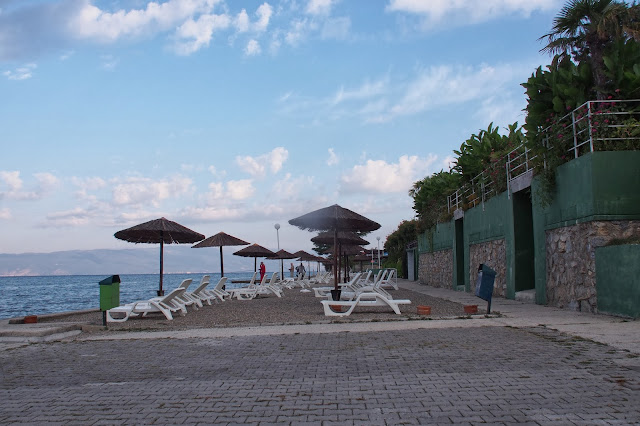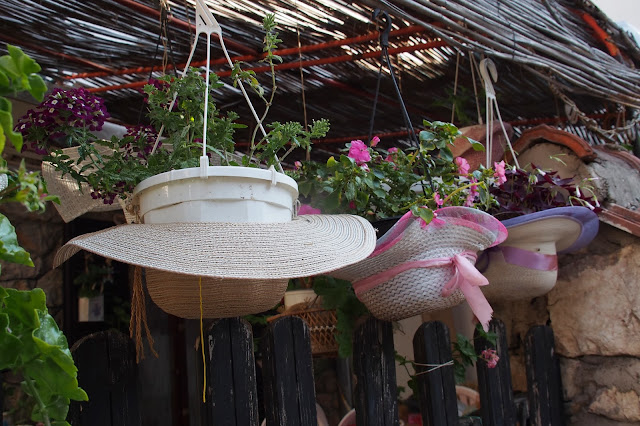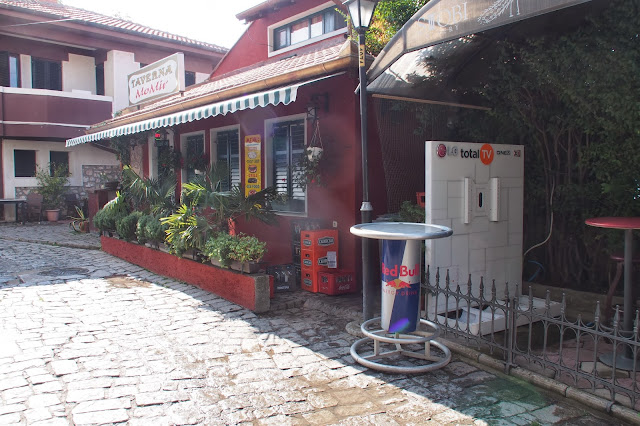Got up early in the morning to get a real look at our hotel in Macedonia
The reflection on the pool looks interesting
A white squid above and trees in the pool!
More reflection in the pool:the water so still. the pool so blue
Got down to the beach: rows of deck chairs awaiting sunbathers
Our path down the lakeside
A panoramic view of our hotel
The fishes were not ready for their hooks
Flowers on the steps
A promenade
The flowers were in bloom
boat shaped flags fluttering in the breeze
an Arabian looking tent by the side of the pool
The statue of St. Clement of Ohrid (Old Church Slavonic: Климє́нтъ Охрїдьскъ, Bulgarian and Macedonian: Свети Климент Охридски (ca. 840 – 916), a medieval Bulgarian saint, scholar, writer and enlightener of the Slavs. He was the most prominent disciple of Saints Cyril and Methodius and is often associated with the creation of the Glagolitic and Cyrillic scripts, especially their popularisation among Christianised Slavs. He was the founder of the Ohrid Literary School and is regarded as a patron of education and language by some Slavic nations and the first bishop of the Bulgarian Orthodox Church, one of the seven Apostles of the Bulgarian Empire (Bulgaria), the patron saint of the Republic of Macedonia, the city of Ohrid and the Macedonian Orthodox Church. According to his hagiography by Theophylact of Ohrid, Clement was born in the southwestern part of the Bulgarian Empire, in the region then known as Kutmichevitsa.He joined in the mission of Cyril and Methodius to Great Moravia. After the death of Cyril, Clement accompanied Methodius on his journey from Rome to Pannonia and Great Moravia. After the death of Methodius himself in 885, Clement headed the struggle against the German clergy in Great Moravia along with Gorazd. After spending some time in jail, he was expelled from Great Moravia and in 885 or 886 reached the borders of Bulgaria together with Naum of Preslav, Angelarius and possibly Gorazd (according to other sources, Gorazd was already dead by that time). Thereafter, the four of them were sent to the Bulgarian capital of Pliska where they were commissioned by Boris I of Bulgaria to instruct the future clergy of the state in the Slavonic language.After the adoption of Christianity in 865, religious ceremonies in Bulgaria were conducted in Greek by clergy sent from the Byzantine Empire. Fearing growing Byzantine influence and weakening of the state, Boris viewed the adoption of the Old Slavonic language as a way to preserve the political independence and stability of Bulgaria. With a view thereto, Boris made arrangements for the establishment of two literary academies where theology was to be taught in the Slavonic language. The first of the schools was to be founded in the capital, Pliska, and the second in the region of Kutmichevitsa.While Naum of Preslav stayed in Pliska working on the foundation of the Pliska Literary School, Clement was commissioned by Boris I to organise the teaching of theology to future clergymen in Old Church Slavonic in Kutmichevitza. For seven years (886-893) Clement taught some 3,500 disciples in the Slavonic language and the Glagolitic alphabet. In 893 he was ordained archbishop of Drembica (Velika), also in Kutmichevica. Upon his death in 916 he was buried in his monastery, Saint Panteleimon, in Ohrid. The invention of the Cyrillic alphabet is also usually ascribed to him although the alphabet is most likely to have been developed at the Preslav Literary School at the beginning of the 10th century. The first modern Bulgarian university, Sofia University, was named after Clement upon its foundation in 1888. The Macedonian National and University Library, founded on November 23, 1944, also bears his name.The University in Bitola (Republic of Macedonia), established in 1979, is named after Clement, as well as the Bulgarian scientific base, St. Kliment Ohridski on Livingston Island in the South Shetland Islands of Antarctica.
This is his name in Cyrillic, which he helped popularize in the Balkans
A tower in Ohrid, beside Lake Ohrid (Охридско Езеро in Macedonia and Liqeni i Ohrit in Albanian) between southwestern Macedonia and eastern Albania.
The narrow streets of Ohrid
All houses are built to withstand earthquake. The masonry is built on top of timbers which can resist being broken much better than a rigid surface. Its style is Turkish

There were also some more modern houses
The people here prefers to use ladies handbag as the support for potted plants
Some would even use ladies hats
A morning glory found outside of the houses on the path
And some chrysanthesum
The streets of the old town had some interesting shops: this one is a wood handcarving stall
The famous St. Sophia church first built in the 11th century, during the First Bulgarian Empire, after the official conversion of Macedonia to Christianity. Some says that it went back to the rule of Knyaz Boris I (852 – 889), others during the rule of Tzar Samuel of Bulgaria (997 – 1014). Originally the synod church of the Archbishopric of Ohrid, it was later converted into a mosque during the rule of the Ottoman Empire.The interior of the church has been preserved with frescoes from the 11th, 12th and 13th century, which represent some of the most significant achievements in Byzantine painting of the time. The main part of the church was built in the 11th century, while external additions were built by Archbishop Grigorie in the 14th century.In November 2009, Macedonian Orthodox Church introduced a new Coat of Arms with the church of St. Sophia as a charge on the shield. A detail from the church is depicted on the reverse side of the Macedonian 1000 denars banknote, issued in 1996 and 2003.
the foundation of the original church
This is a barrel of ashes for candles
The plaque of the church
this is a model of the church placed in the garden outside
Its stained glass window
A view of the old church
Its wooden door
the buildings at the back of the church
The rear of the church
Some of the original carvings
The church grounds are protected by this reinforcing wall

Another view of the ancient church

It's a simple church

Supported by many columns
The old town built on a small hill
The locals are fond of flowers
Flowers growing beside a wall

A view of Lake Ohrid, the deepest and oldest lake in Balkans, with more than 200 endemic species of fishes inside and declared a World Heritage site by UNESCO in 1979. Surrounding the lake are 3 towns Pogradec in Albania and Ohrid and Struga in Macedonia. It's covers an area of 138 miles and goes down 940 feet at its deepest and has a shoreline of almost 90 km (56 km in Macedonia and 32 in Albania) with 248 km2 of its surface area belonging Macedonia and 110 km2 belonging to Albania. The lake drains an area of around 2600 km². Half of its inflow is from underground springs on the eastern shore, a quarter from rivers and rain and a fifth from a higher lake 6 miles away, the Lake Prespa through a system of underground karst rivers. Its water drains into the Black Drin River, which flows into north Albania and then the Adriatic Sea.Lake Ohrid qualifies as oligotrophic, thanks to which and its filtered spring inflows, its water is exceptionally clear with transparencies to a depth of as much as 22 meters (66 feet). A third of its 21 native fish species and four fifths of its molluscan fauna is endemic. Its shore reed beds and wetlands provide critical habitat for hundreds of thousands of wintering water birds, including rare and threatened species such as the Dalmatian Pelican, Ferruginous Duck, Swan, Spotted Eagle, and Eastern Imperial Eagle.The lake supports the lives of some 170,000 people with 130,000 living directly on its shores (43,000 in Albania and 88,000 in Macedonia). Because of its pristine water, it attracts some 200,000 tourist a year, some local and some international. But due to overfishing and destruction of spawning ground, the population of two endemic trout species has dropped significantly over the past decades, both in Macedonia and in Albania. To reverse the trend, fishing has been banned for the past two years.

Its shores are littered with boats

Part of the lake shores close to town are lined with restaurants
We were given a short tour of the old town
We had to walk below some houses
The lake shores are lined with many restaurants
This one has a shed which leads to the shore
This one looks more conventional
I like its windows and the way they decorate it with creepers
It would be nice if we were to have our lunch here.
We had to move on
More lake side restaurants
The lake shore
More lake shore. how blue the sky!
The shingles on the lake shore
The park in front of the lake
This girl is learning how to canoe, watched over by her friends
I could actually see the water weeds growing right beside the shore of the lake
The pier
In the background, we see the little town
boats for hire
some swans swimming by
A happy grandpa and his granddaughter. They were feeding the swans
One of the boats for water tours
One of the piers
From the pier, one gets a good view of the lake
going back to our rendezvous point
An achor
Tourists resting on a park bench
The park with its colorful flowers
Doesn't this tree look like a dinosaur?
The park is located right beside the old town
Some purple morning glories at the park
A local who posed for me

One of the local saints around whom we were supposed to meet

She is protected by a tree
Some local children
Another local girl: she looks so happy









































































沒有留言:
張貼留言